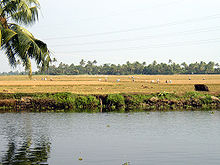Backwaters
The backwaters are a branched network of waterways in the hinterland of the Malabar Coast in the southern Indian state of Kerala . They extend from Kochi in the north to Kollam in the south over a total area of 1900 km².
Waters
The backwaters include 29 larger lakes and lagoons , 44 rivers and a total of around 1500 kilometers of canals and natural waterways.
The largest lake is the 83 km long Vembanad Lake , which is open to the Arabian Sea . Other large bodies of water are the Ashtamudi and Kayamkulam lakes .
41 of the 44 rivers that cross the backwaters flow west to the Arabian Sea, three flow east.
Ecosystem
Due to the high population density, the backwaters are today an ecosystem that is heavily influenced by humans. The original vegetation of the wet forests and mangroves had to give way mainly to coconut and rubber plantations . In most areas, such as the fertile Kuttanad lowland, rice is also grown, which only thrives in fresh water. Therefore, barriers were built, for example near Kumarakom and Kayankulam. They prevent the salt water from mixing with the fresh water. The fresh water is used intensively for irrigation.
The mostly slow-flowing, brackish waterways are increasingly polluted by agrochemicals, industrial sewage, garbage and faeces. Crocodiles and many migratory fish species are already extinct. In contrast, water hyacinths spread freely. In many places, aquatic plants, the food source of many fish, die off due to a lack of light in overgrown canals.
Another problem is the increasing narrowing of the backwaters by humans. Since the mid-19th century, the backwaters have shrunk to around a third of their original size. The cause is the partially illegal drainage of water bodies to gain agricultural land and settlement area. The Vembanad Lake alone shrank from 230 km² to now only 179 km².
Importance to humans
Agriculture
The backwaters are used intensively for agriculture. Coconut palms, rubber , rice and cashew trees are the most important crops. Coconut fibers are mostly processed by hand. In addition, fishing and breeding are important. Numerous agricultural areas have been gained by diking flat sections of the lake. The usable areas below sea level have to be constantly drained.
Traffic routes
The backwaters have served as trade and traffic routes for centuries. The locals particularly use the traditional barges called Kettuvallam to transport goods . Ferries run regularly on many channels.
tourism
For several years the importance of the backwaters as a travel destination, especially for foreign tourists, has been increasing steadily. Boat trips lasting several hours are offered from Kollam , Alappuzha and Kottayam . In Kollam and Alappuzha you can also rent Kettuvallam converted into houseboats for longer periods. In some villages, Kathakali demonstrations are held regularly for visitors .
Web links
Coordinates: 9 ° 51 ′ 19 ″ N , 76 ° 20 ′ 43 ″ E




